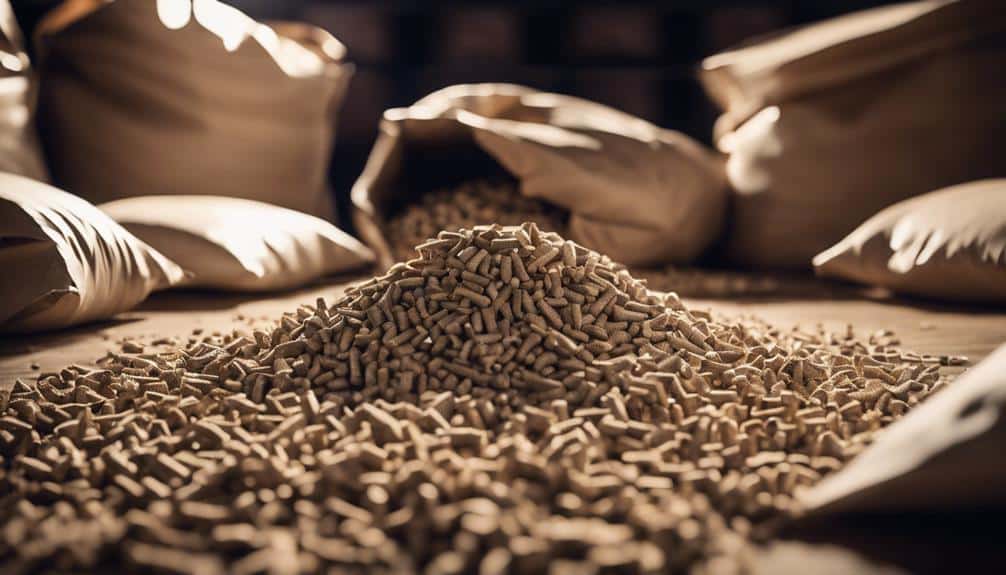Table of Contents
Buying wood pellets by the ton can greatly reduce your heating expenses and environmental impact. Start by evaluating your heating needs and storage capacity. Ideal moisture content (6-8%) and the right pellet type guarantee efficient combustion and minimal ash. Premium pellets might cost more upfront but provide better heating efficiency and lower maintenance. Bulk purchases save money and reduce packaging waste. Store your pellets in a dry, ventilated area to maintain quality. Consider vendor reputation, delivery options, and product certifications like ENplus or PFI for quality assurance. With these guidelines, you’re ready to make a smart, cost-effective choice. Who knew warmth could be this efficient?
Key Takeaways
- Determine heating needs and storage capacity to buy the right tonnage of wood pellets efficiently.
- Opt for premium or hardwood pellets with low moisture (<8%) and ash content (<0.7%) for high efficiency and minimal maintenance.
- Consider bulk buying to save costs, reduce packaging waste, and minimize transportation emissions.
- Select vendors with positive reviews, quality certifications (ENplus, PFI), and competitive bulk pricing and delivery options.
- Store pellets in dry, well-ventilated areas in moisture-resistant containers to maintain quality and ensure long-term efficiency.
Understanding Pellet Fuel
Pellet fuel, derived from compressed sawdust and wood waste, offers an efficient and eco-friendly alternative for heating. It is characterized by its precise processing into specific sizes and moisture contents to guarantee perfect combustion. This innovative solution taps into the abundance of wood waste, transforming it into a powerhouse of heat generation. By compressing sawdust and other wood byproducts, pellet fuel achieves a density that is prime for efficient combustion, releasing a consistent and controlled heat output. This meticulous approach not only maximizes the energy extracted from each pellet but also guarantees a cleaner burn, reducing emissions compared to traditional heating methods.
The essence of pellet fuel lies in its eco-friendliness and renewable nature. As it repurposes wood waste, it diverts material from landfills, contributing to a more sustainable cycle of resource use. Its uniformity in size and moisture content, as a result of strict processing standards, means that when you load your pellet stove, you’re assured of an excellent burn every time. This not only enhances the efficiency of your heating system but also optimizes fuel consumption, making pellet fuel a smart choice for those seeking to marry environmental responsibility with heating efficiency.
Selecting the Right Size
After understanding the benefits and efficiency of pellet fuel, the next essential step is selecting the correct quantity and size to meet your specific heating needs. This decision is vital for guaranteeing a warm, comfortable home throughout the heating season without unnecessary expenditure or shortage of supply. Here’s how to navigate this process:
- Determine Heating Needs: A ton of wood pellets typically delivers about 16 million BTUs of heat. Assess your home’s size, insulation quality, and the efficiency of your pellet stove to calculate the tonnage needed for the entire heating season.
- Storage and Budget: Consider both your storage capacity and budget constraints. Buying in bulk often saves money, but make sure you have adequate, dry storage space to keep the wood pellets in ideal condition.
- Climate and Usage Frequency: Factor in your local climate and how frequently you’ll be using the pellet stove. Colder climates or daily usage demands more pellets, influencing the size of your purchase.
Moisture Content Matters
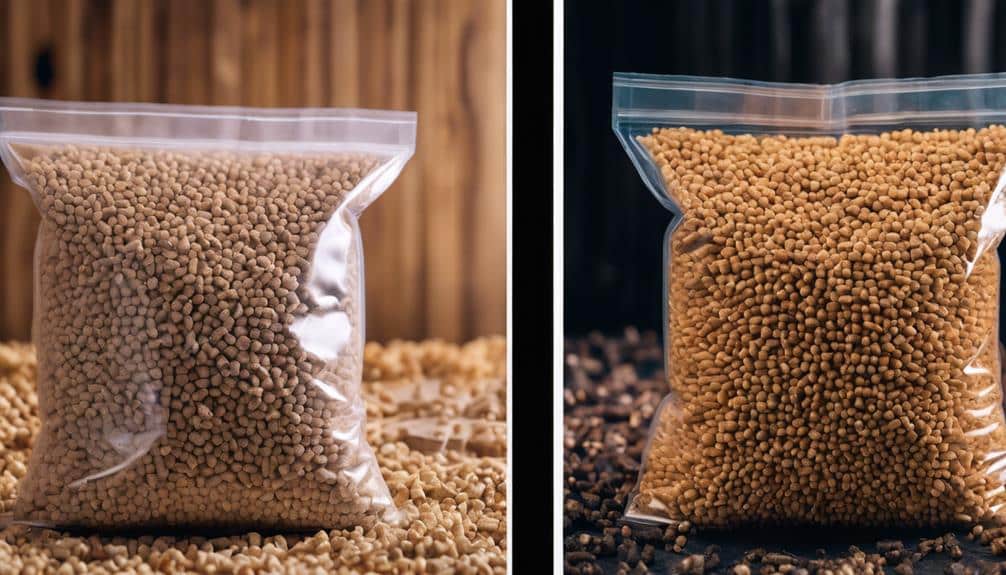
Understanding the moisture content of wood pellets is essential for ensuring they burn efficiently and effectively in your stove. Ideal moisture content, typically around 6-8%, is vital for efficient combustion, which translates into maximum heating efficiency and performance. When moisture content veers higher, it can greatly lower the heat output and increase ash production, making your heating process less efficient and more cumbersome.
Excess moisture not only hampers the ignition process, leading to difficulties in starting your stove but also results in incomplete burning. This inefficiency can manifest as smoldering pellets that fail to deliver the desired warmth while simultaneously increasing maintenance needs due to higher ash content. Conversely, wood pellets that are properly dried and maintain the ideal moisture content facilitate cleaner combustion. This not only enhances stove performance but also reduces the frequency and intensity of maintenance required.
For enthusiasts aiming to master the art of pellet stove heating, paying attention to, and maintaining, the moisture content of your wood pellets is indispensable. It’s a fundamental aspect that directly impacts the efficiency and cleanliness of your heating solution, ensuring that your living space remains comfortably warm without unnecessary hassle or expense.
Brand and Type Comparison
Exploring the variety of wood pellet brands and types is essential for maximizing the performance and efficiency of your pellet stove. With a myriad of options available, honing in on the right selection can greatly elevate your heating experience. Here are three pivotal considerations when conducting a brand and type comparison:
- Heat Output and Ash Content: Premium pellets are renowned for their high BTU (British Thermal Unit) ratings and minimal ash content, ensuring cleaner combustion and less maintenance. Different brands offer varying levels of heat output and ash production, directly impacting your stove’s efficiency and the frequency of cleanings required.
- Material: Hardwood pellets typically deliver longer burn times and higher heat efficiency compared to their softwood counterparts. This distinction is important for users seeking prolonged warmth without the constant need to reload their stove.
- Compatibility and Performance: Some pellets are engineered for specific stove types, affecting combustion and overall performance. Additionally, the moisture content of the pellets can influence their burn quality. A thorough brand comparison should include an evaluation of how well pellets match with your stove’s requirements and their moisture levels to avoid suboptimal burning.
Understanding these factors allows you to make an informed decision, ensuring that you select the most suitable wood pellets for your heating needs.
Bulk Buying Benefits
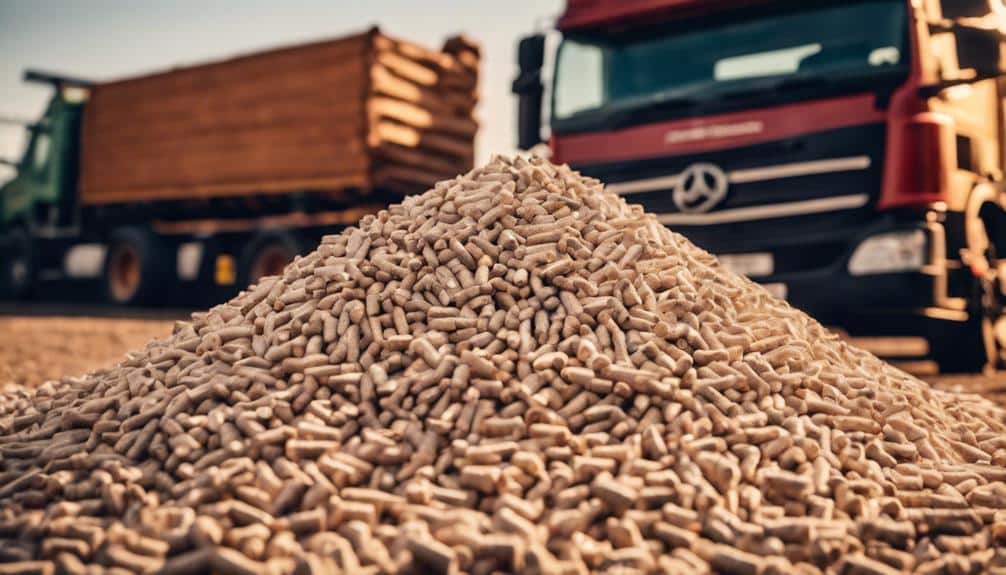
Exploring the benefits of bulk buying wood pellets reveals a trio of compelling advantages:
- Cost savings: By purchasing in large quantities, consumers can enjoy lower prices per ton, ensuring their pellet stove remains an economical choice throughout the heating season.
- Streamlined supply chain: This approach simplifies the logistics of maintaining a steady fuel supply, making it easier for consumers to manage their heating needs efficiently.
- Lesser environmental footprint: Bulk buying contributes to sustainability efforts by reducing packaging waste and transportation emissions, aligning with eco-friendly practices.
These advantages make bulk buying wood pellets an attractive option for those looking to save money, streamline their supply chain, and reduce their environmental impact.
Cost Savings Explained
In the world of heating solutions, purchasing wood pellets in bulk emerges as a particularly cost-effective strategy, with potential savings far outweighing those of smaller, individual purchases. Here’s why:
- Bulk prices average between $240 to $280 per ton, notably lower than the $6 to $10 per bag, illustrating the stark cost difference and savings potential.
- Delivery costs for bulk orders, though varying from $50 to $120, become more palatable when spread across a larger quantity of pellets, effectively reducing the overall cost per ton.
- Quality certifications ensure you’re getting a product worth your investment, and when buying in bulk, the guarantee of quality doesn’t necessarily mean a higher price tag.
Opting for bulk purchases not only makes sense financially but also guarantees a consistent, quality supply for your heating needs.
Streamlined Supply Chain
Bulk purchasing of wood pellets offers significant advantages for consumers. By opting for bulk buying, customers can enjoy cost savings of up to 20% compared to smaller purchases, with discounts of up to $100 per ton. This approach not only saves money but also ensures a steady and reliable supply of heating material. The streamlined supply chain from bulk orders minimizes reordering hassles and secures a consistent supply for extended periods, making it practical for those relying on wood pellets for heating. Additionally, the efficiency of bulk orders often leads to reduced delivery costs, further enhancing the cost-effectiveness for consumers. Overall, the combination of savings and efficiency makes bulk buying an attractive option for savvy buyers.
Environmental Impact Reduction
Opting for bulk buying of wood pellets significantly reduces environmental impact by minimizing packaging waste and transportation emissions. By choosing to purchase wood pellets by the ton, individuals and businesses can greatly lower their carbon footprint. This sustainable approach offers a trifecta of environmental benefits:
- Reduced Packaging Waste: Bulk purchases eliminate the need for multiple smaller packages, thereby decreasing the amount of waste generated.
- Fewer Transportation Emissions: By decreasing the frequency of deliveries, bulk buying contributes to lower emissions from transportation.
- Support for Sustainable Practices: Purchasing in large quantities underscores a commitment to sustainable energy use, reinforcing the importance of reducing our overall carbon footprint.
For those looking to master the efficiency and environmental impact of their heating solutions, buying wood pellets by the ton is a profoundly impactful choice.
Storage Solutions
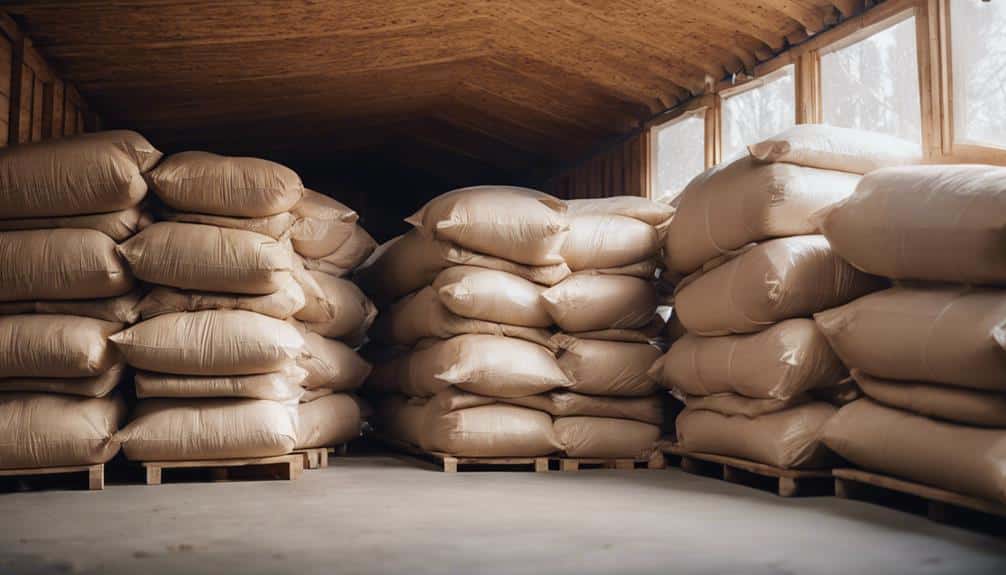
As we move on to the topic of ‘Storage Solutions‘ in our Wood Pellets Buyer’s Guide, it’s important to highlight that selecting the right storage methods can have a major impact on the longevity and quality of your wood pellets.
From ensuring your storage area is dry and well-ventilated to choosing moisture-resistant containers and optimizing space with stackable solutions, there are several strategies to maintain your pellets in top condition.
Understanding the importance of moisture control, space efficiency, and the ideal conditions for storing your wood pellets will not only safeguard your investment but also guarantee the best performance when it’s time to use them.
Optimal Storage Conditions
Ensuring wood pellets are stored in a dry, low-humidity environment is essential for maintaining their quality and longevity. The ideal storage conditions for wood pellets involve more than just keeping them dry; it’s about understanding the nuances that preserve their integrity.
Consider these pivotal elements:
- Storage Temperature: Keep wood pellets in areas where the temperature is consistently between 40-90°F to prevent the pellets from deteriorating.
- Protection from Elements: Airtight containers or sealed bags are critical to shield the pellets from moisture and air, greatly extending their usability.
- Sunlight and Moisture Avoidance: Direct exposure to sunlight and moisture can lead to clumping or degradation, compromising the fuel quality.
Adhering to these guidelines ensures that your investment in wood pellets remains a viable, efficient energy source for your needs.
Space Efficiency Tips
Maximizing storage efficiency for wood pellets requires innovative solutions that both preserve their quality and save space.
By utilizing stackable wood pellet storage bins, individuals can dramatically enhance their storage capacity without sacrificing precious floor space.
For those with limited ground area, vertical shelving or wall-mounted racks offer efficient storage solutions that make use of underutilized vertical spaces.
Airtight containers or bags are essential for keeping wood pellets dry and maintaining their quality, ensuring that your investment doesn’t go to waste.
Additionally, under-bed storage containers provide a discreet and space-saving option for those looking to keep their wood pellets out of sight but within easy reach.
Moisture Control Methods
Maintaining the correct moisture level in wood pellets is essential for their storage and subsequent burning efficiency, necessitating the implementation of effective moisture control methods. To guarantee the longevity and peak burning efficiency of wood pellets, consider the following storage techniques:
- Store in a Dry Area: Aim for areas with humidity levels below 50% to prevent moisture absorption.
- Use Airtight Containers: Sealed bags or containers are key in preserving the quality of wood pellets by blocking moisture.
- Regular Moisture Checks: Utilize moisture meters to monitor the moisture content, ensuring it remains within the ideal range of 5-10%.
Quality Indicators
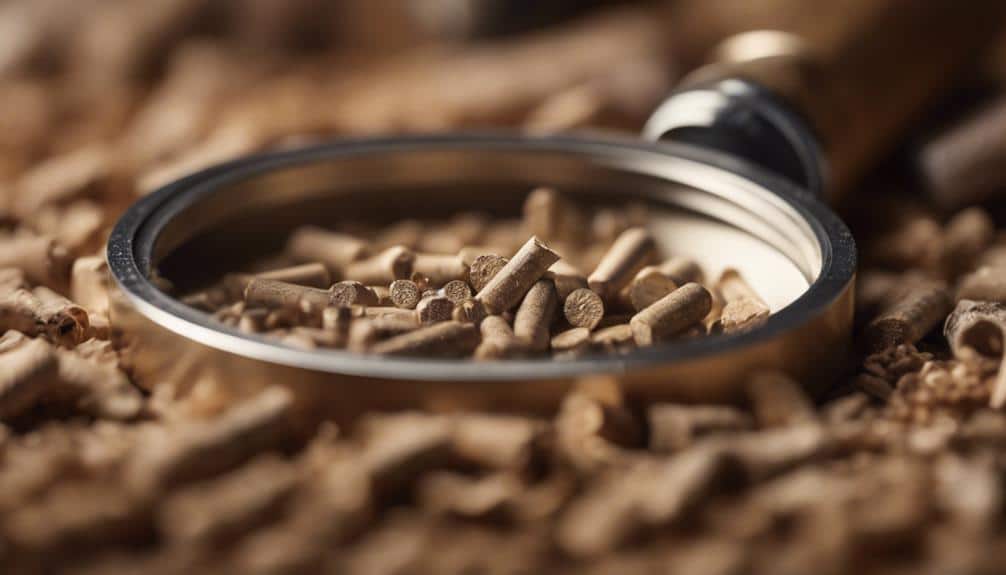
When delving into wood pellets for heating, identifying key quality indicators is crucial to achieving efficient and clean energy output. The quest for the perfect pellet involves scrutinizing several factors that directly impact their performance in your heating system. Let’s explore these indicators to make sure you’re making an informed decision.
| Quality Indicator | Ideal Value | Why It Matters |
|---|---|---|
| Moisture Content | Below 8% | Ensures efficient, clean burning |
| Ash Content | Less than 0.7% | Minimizes maintenance, maximizes heat |
| Type of Wood | Hardwood | Longer burn times, higher heat output |
| Quality Certifications | ENplus, PFI | Guarantees industry-standard performance |
| BTU Rating | Above 8,000 BTU/lb | Indicates high heating efficiency |
Paying close attention to these quality indicators can significantly enhance your heating experience. Opting for pellets with low ash content and moisture levels ensures your stove remains clean and efficient, reducing maintenance and fuel waste. Additionally, hardwood pellets are the champions of longevity and heat production, making them a superior choice for those seeking the most bang for their buck. Lastly, don’t overlook the importance of quality certifications like ENplus or PFI; these are your assurance that the pellets meet stringent performance and environmental standards.
Cost Analysis
Understanding the quality indicators of wood pellets sets the stage for an equally important consideration: the cost analysis of purchasing these heating essentials. The price tag attached to a ton of wood pellets is influenced by several factors, including the quantity purchased, delivery charges, and the pellets’ quality.
Here’s a deeper exploration into the financial aspects:
- Bulk Orders: On average, the cost per ton of wood pellets ranges from $300 to $400. However, opting for bulk orders can markedly reduce the price to between $240 and $280 per ton. This highlights the importance of planning and investing in larger quantities to achieve cost savings.
- Delivery Costs: These can vary widely, from $50 to $120, depending on factors such as distance and supplier. It’s essential to factor these additional expenses into the overall cost analysis to avoid surprises.
- External Influences: Seasonal factors, market demand, and geographic location play important roles in determining the final price of wood pellets. Additionally, pellets that meet certain quality certifications and standards may command a higher price, but they also ensure greater efficiency and performance, potentially offsetting the initial cost over time.
Vendor Selection

Choosing the right wood pellet vendor is an important decision that can greatly impact both the quality of the product and the overall cost-effectiveness of your heating solution. When evaluating this choice, the vendor’s reputation, underscored by customer reviews and their years in business, plays a key role. These elements are indicative of the reliability and quality you can expect.
Moreover, savvy buyers should look for vendors that offer bulk discounts and flexible delivery options. Such benefits can significantly reduce the total investment in your heating needs. Additionally, certifications like ENplus and the Pellet Fuels Institute (PFI) mark are signs of premium-quality wood pellets, ensuring you’re purchasing a product that meets high standards for performance and environmental sustainability.
Before settling on a vendor, it’s wise to compare pricing, delivery fees, and customer service policies among different suppliers. This comparison helps in identifying the most value-packed offer. Finally, tapping into the local network of pellet stove retailers or heating professionals for vendor recommendations can lead you to trusted sources, further refining your selection process. Prioritizing these aspects during vendor selection will lead to a satisfactory purchase, marrying quality with cost efficiency.
Maintenance Tips
Maintaining your wood pellet heating system is key to ensuring its longevity and efficiency.
This includes proper storage methods to keep the pellets dry and in good condition, along with regular cleaning procedures for the system’s internal components.
Proper Storage Methods
Ensuring the longevity and effectiveness of wood pellets hinges on adopting appropriate storage methods that prevent moisture absorption and degradation. Mastery in maintaining your pellet supply involves understanding and implementing a few key practices:
- Store in a Dry, Ventilated Area: Keeping wood pellets in a space where air circulates freely minimizes the risk of moisture buildup. This is important for preserving their quality and combustibility.
- Use Moisture-Resistant Containers: Opt for containers or bags that fend off humidity. This simple step can greatly extend the life of your pellets by keeping them dry.
- Avoid Direct Contact with Concrete and Extreme Conditions: Placing pellets on concrete can invite moisture. Also, shield them from direct sunlight and drastic temperatures to maintain their integrity.
Regular Cleaning Procedures
To ensure the longevity and efficiency of your pellet stove, it is essential to adhere to a regimen of regular cleaning and maintenance. Ensuring peak performance means getting hands-on with the burn pot and heat exchangers; a wire brush or scraper becomes your best ally in combating ash buildup, important for unimpeded pellet combustion.
Don’t overlook the aesthetics – a clean glass door not only enhances your fire-viewing experience but also reflects well on your maintenance habits. A thorough vacuuming of the stove’s interior and venting system is necessary for preventing blockages and preserving airflow.
Above all, committing to annual professional maintenance checks safeguards against unforeseen issues, securing the safe and efficient operation of your pellet stove.
Frequently Asked Questions
Is It Cheaper to Buy Wood Pellets in Bulk?
Yes, purchasing wood pellets in bulk is generally less expensive, as it offers savings through lower per-unit costs, reduced delivery fees, and potential discounts. Considerations should include storage solutions, delivery options, seasonal pricing, and supplier reputation.
What to Look for When Buying Pellets?
When purchasing pellets, prioritize pellet quality, ensuring low moisture content for efficiency, minimal ash production for cleaner combustion, and verify sustainability claims for environmental responsibility. Evaluating these factors guarantees peak performance and sustainability of the product.
How Long Will 1 Ton of Wood Pellets Last?
The longevity of a ton of wood pellets hinges on burn rate, pellet quality, usage frequency, and storage conditions. Properly stored, high-quality pellets burned at an efficient rate can extend usage across heating seasons.
How Many 40LB Bags Are in a Ton of Wood Pellets?
A ton of wood pellets comprises 50 bags, each weighing 40lbs. This standard bag dimension facilitates efficient storage solutions, pallet handling, and minimizes environmental impact, offering a sustainable heating solution for those prioritizing eco-conscious fuel options.
Conclusion
To sum up, maneuvering through the world of wood pellets by the ton requires a blend of knowledge and practicality. Understanding pellet fuel, selecting the right size, considering moisture content, comparing brands and types, recognizing the benefits of bulk buying, identifying quality indicators, conducting a cost analysis, choosing the right vendor, and adhering to maintenance tips are essential steps.
By being informed and cautious, one can guarantee an efficient and cost-effective purchase, contributing to both environmental sustainability and the warmth of one’s home.

